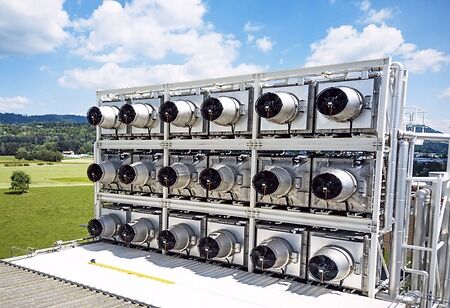
The Planet Needs to Chill; Will DAC Method Help?


An intense heat wave swept northern India last summer. The temperature hit 49.2 C in the capital. Delhi government had recently commissioned two Smog Towers to clean the atmosphere. But it doesn't seem to help much anyway. Climate change continues to occur. The climate change of the next few years depends on how much heat is trapped due to the emission of the gasses as well as the earth's reactions for those emissions. According to the reports, 27 percent of the greenhouse gasses are emitted from the transportation sector. Around 90 percent of the fuel used in the transportation sector is petroleum, containing gasoline and diesel.
According to the International Energy Agency, the global carbon dioxide emissions shifted to 36.3 billion tons last year. As the emission is rising, governments worldwide are keen to capture or reduce the carbon from the atmosphere. So the researchers from Japan, Dr. Seiji Yamazoe, and his team from Tokyo Metropolitan University, have come up with a new system to capture the carbon dioxide from the environment and convert them into crystals.
How does Carbon Dioxide Increase Global Warming?
When sunlight reaches the earth’s surface, the earth absorbs it and converts it into infrared radiation, and gives it back to the atmosphere. Oxygen and the nitrogen present in the atmosphere don’t interfere with the infrared radiations because they are picky about the range of wavelengths. Oxygen and nitrogen absorb the energy that will have a wavelength of 200 nanometers. The infrared has a wavelength of 700 to 10000 nanometers. But for CO2 and other greenhouse gasses, it is different. CO2 absorbs energy between 2000 and 15000 nanometers. Co2 soaks up with the infrared radiation, and the amount of the energy reverted back to space will be spread to the earth's atmosphere. This causes the greenhouse effect.
Direct Air Capture (DAC) Removes CO2 from the Air and Liquid Chemical Medium
Researchers say that capturing CO2 from the air is not easy. It requires advanced technologies as well as experts. The ambient air consists of 400ppm of CO2 out of 0.04 percent of the total air. Researchers used a liquid chemical medium to isolate CO2 from the air before separating it from the high heat. Introducing the point-source CCS (Carbon Capture and Storage) will not be sufficient to stabilize the atmospheric CO2 concentration at the desired level. It will require achieving ‘negative emissions,’ that is, reducing the amount of CO2 in the atmosphere by separating it from atmospheric gasses.
The equipment consists of four major components. The process starts with the air contractor, which has a giant fan that pulls air towards the structure. Then the air flows through the potassium hydroxide solution flowing over them. The non-toxic solution forms a bond with CO2 in the air and converts carbonate salt.
Because of the low concentration of CO2 in the atmosphere, that is ~400 ppm, an effective and economical direct air capture (DAC) requires a sorbent that optimally combines a number of attributes such as strong CO2- binding affinity, fast sorption kinetics, high capacity, good selectivity against other components in the air especially water, easy regeneration with minimal energy input, long-term stability, and low cost. Moreover, a material with all these characteristics has yet to be identified. Sustained efforts in the last two decades led to the development of different classes of sorbents with promising DAC performance, such as alkali and alkaline earth bases, for example, NaOH, KOH, Ca(OH)2 solid-supported amine-based sorbents, and metal-organic frameworks (MOFs). Most systems used today in DAC consist of chemisorbents, taking advantage of their strong and selective binding of CO2 in the form of carbonate or carbonate anions. Unfortunately, an undesirable consequence associated with strong CO2 binding is the typically high temperatures required to release the gas and regenerate the sorbent.
Steve Oldham, CEO, Carbon Engineering, says, “We have a climate change problem and it's caused by an excess of CO2. With DAC, you can remove any emission, anywhere, from any moment in time. It's a very powerful tool to have.”
Besides, if the sorbent is in the aqueous state, a substantial amount of energy is required to heat the solutions due to the high heat capacity of water. For instance, aqueous NaOH, a benchmark chemisorbant for DAC, has a very high capacity and fast kinetics of CO 2 absorption. However, the resulting sodium carbonate is too soluble in water, requiring a substantial amount of energy to concentrate the solution and isolate the solid Na2 CO3, which then needs to be calcined at temperatures above 800 °C to decompose it into CO 2 and Na2O. Alternatively, the aqueous Na2CO3 solution can be reacted with Ca(OH)2 to precipitate CaCO3 and regenerate the NaOH solution, but the thermal decomposition of calcium carbonate to release the CO2 requires very high temperatures of about 900 °C. Thus, the sorbent regeneration step is by far the most energetically demanding and expensive component of the overall DAC process, prompting the development of new sorbent materials with lower regeneration temperatures. The simple aqueous guanidine sorbent that captures CO2 from the air and binds it in the form of crystalline carbonate salt of low aqueous solubility then undergoes the further process.
The salt from the solution is separated by small pellet-like structured equipment called a pellet reactor. It is heated through a calciner process to release the CO2 in the pure gaseous form. The left-behind pellets are then hydrated through the slackers and then sent back again to the primary procedure.